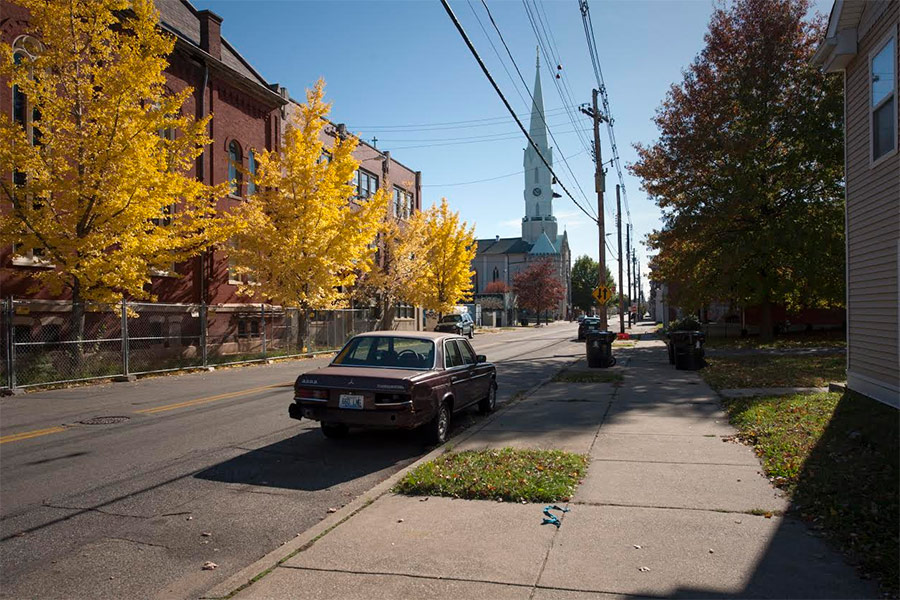Broken Sidewalk readers know their local geography. Mary Anne correctly identified last week’s sidewalk challenge as Douglass Boulevard looking east from Bardstown Road. Well done. Up above is a new sidewalk challenge in full Fall glory ready to be identified in the comments below.
And now on with this week’s top ten editors’ picks for urbanism news.
- How Anchor Institutions Like Hospitals and Universities Can Help Cities. An old idea reimagined. Tanvi Misra argues that by combining government oversight and subsidy; institutions such as universities and hospitals can work as job creators for communities without creating overly disruptive neighborhood change. CITYLAB
- Are Single Family Teardowns a Sign of Suburban Gentrification? James Brasuell explores the possible gentrification of suburban neighborhoods through the tearing down and redevelopment of larger mansion style housing in Chicago Neighborhoods. Planetizen
- A City Without Zoning? Phnom Penh, Cambodia’s Development Runs Wild. Global Site Plans explores the possible environmental and economic dangers of a rapidly growing city with no enforceable zoning plan. Sustainable Cities Collective
- Could Free Public Transit Get Americans to the Voting Booth? Is there a direct link between free public transit and voter turnout? Sam Sturgis investigates a issue central to planning and democracy. CITYLAB
- Is America’s Civic Architecture Inherently Racist? Dean Saitta engages in an interesting debate between accessibility, authenticity, and the implications of aesthetics in public spaces for minority populations. Planetizen
- They’re Still Redlining. Wall Street has developed new forms of housing discrimination to profit off communities of color. Jacobin
- In the Dust of This Planet. BLDGBLOG looks at a recent New York Times piece about cities constructed to test nuclear bombs. One of which is a mere 14 miles away from the Eiffel Tower. These spaces are beginning to become sites of reuse and regeneration. BLDGBLOG
- Urban Infrastructure Plopped in Nature is Oddly Disturbing. By juxtaposing urban infrastructures with ‘Natural’ environments, Tanja Deman creates an interesting conversation around the false dichotomy between settlements and nature. CURBED
- ‘Open by Default’: Louisville Opens Data to the Public. Louisville has shown leadership in the open data movement by doubling the amount of data it shares with the public in the past year. WFPL
- You are Now Entering an Active Urban Renewal Area. By overlaying all of New York Cities urban renewal maps (both active and inactive) with vacant properties (which line up almost perfectly and not coincidentally), Paula Segal (596Acres.org) and company hope to create a data visualization tool that will allow communities to take an active role in the development of and around their communities. Urban Omnibus



Shelby St @ Gray
Corner of Shelby and Chestnut Street, in Phoenix Hill. I had to evaluate the condition of the Church on that corner (which is adjacent to the Cloister Apartments) as part of an internship with New Directions, and found it to be in shockingly poor condition. Decorative stone and brick elements are falling apart, the gutters are all but gone, and a tree is growing out of one of the walls. The worst thing is that the steeple is leaning at a surprisingly obvious and precarious looking angle. Keep an eye on this one, because I wouldn’t be surprised if it showed up on the city’s emergency demo list in the next few years.
The Cloister. A designated local landmark. The city should cite the owner for failure to maintain. If there is still a landmarks ordinance it’s in violation. Demolition by neglect.
@Debra – A quick check on LOJIC shows that the Cloister and the church are on two different lots, with two different owners.
I was looking ahead south at Gray St, not the corner. That block immediately east on Chestnut is one of the few remaining intact blocks in this area. It was just far enough east to escape urban renewal.